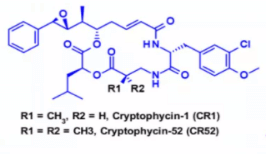Toxins/Payloads (Classification and function) of Microtubule destroying drug
There are so many payloads, like MMAE, Calicheamicin, MMAF, DM1, SN-38 and Dxd.
Calendula
Auristatins is an important payload used in ADC. The most famous family member MMAE exists in two listed drugs, adcetris and Polivy. At present, more than 10 kinds of ADCs with calendula (such as MMAE) or methylcalendula f (MMAF) as payload are undergoing clinical trials.

The figure above describes auristatine and its common connection sites. The structure-activity relationship (SAR) of Calendula has been widely studied, mainly focusing on the terminal subunit: P1 (N-terminal) and P5 (C-terminal). The most common method is to introduce carbamate function on P1.
Meidengsu derivatives (DM2, DM4)
Metanthin is a very effective inhibitor of microtubule assembly, which can induce the cessation of cell mitosis. However, this structure is difficult to conjugate because it has no reactive functional groups. In order to overcome this problem, a series of very effective derivatives containing SME groups have been created. The first examples of such molecules are DM1 and DM4, which carry methylthiopropionyl rather than natural N-acetyl groups.

Microtubule lysin
Tubulysins is an effective inhibitor of microtubule polymerization, which can lead to the rapid disintegration of the cytoskeleton of dividing cells and apoptosis. They are a naturally occurring tetrapeptide family containing Mep, Ile, Tuv and Tut, R3 = OH or Tup, R3 = H.

Cryptomyxin
Cryptomyxin (CR) is a family of six membered macrocyclic dipeptides with antitumor activity. The results of existing clinical trials show that the toxicity level is unacceptable at the dose required to achieve the therapeutic effect.

Anti-mitotic Eg5 inhibitor
Spindle kinesin (KSP, also known as Eg5 or kif11) is an ATP dependent motor protein involved in the separation of cell cycle centrosomes. Therefore, blocking this important event in mitosis with KSP inhibitors (kspis) can produce antitumor efficacy.






 View the Knowledge base of Antibody-drug Conjugate (ADC):
View the Knowledge base of Antibody-drug Conjugate (ADC):